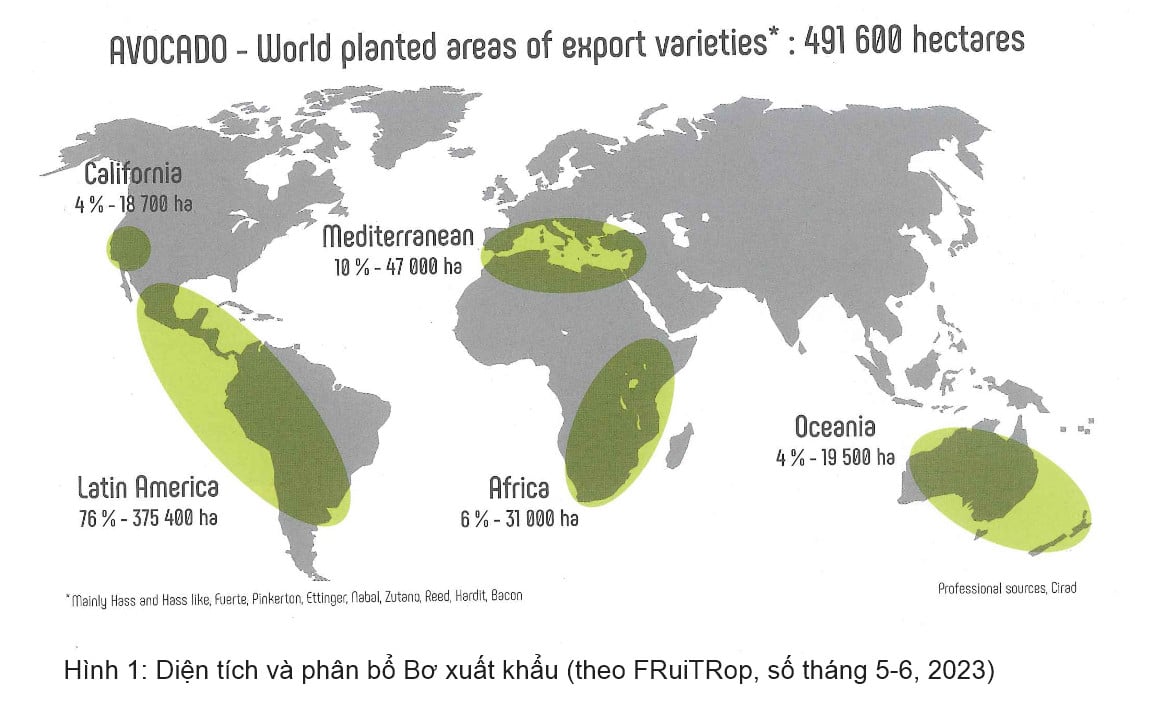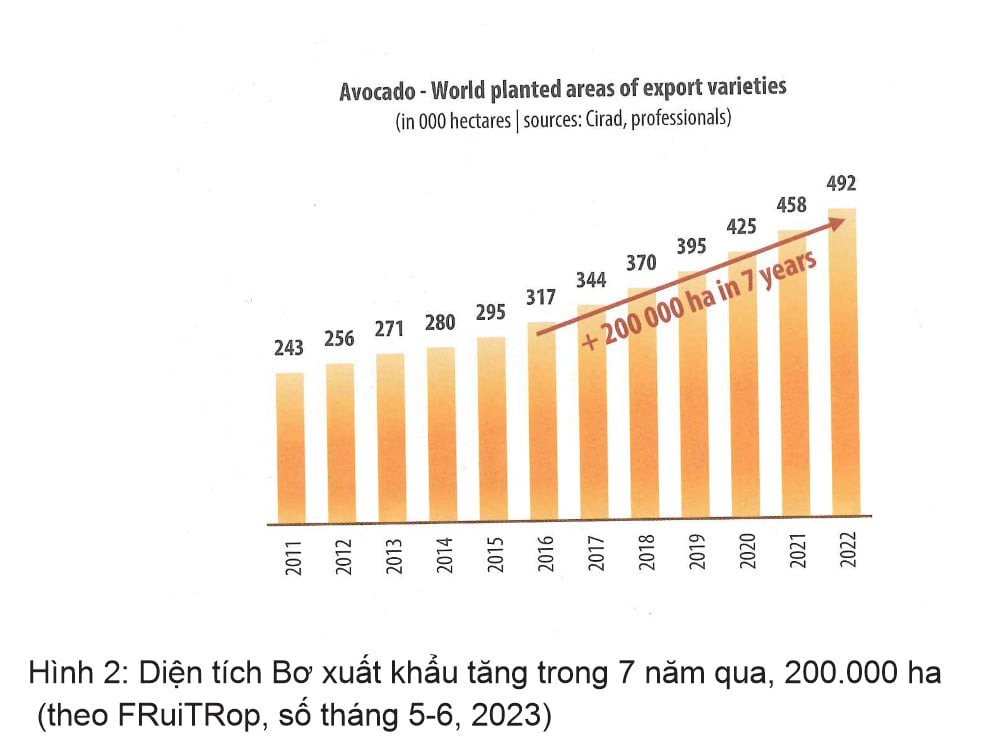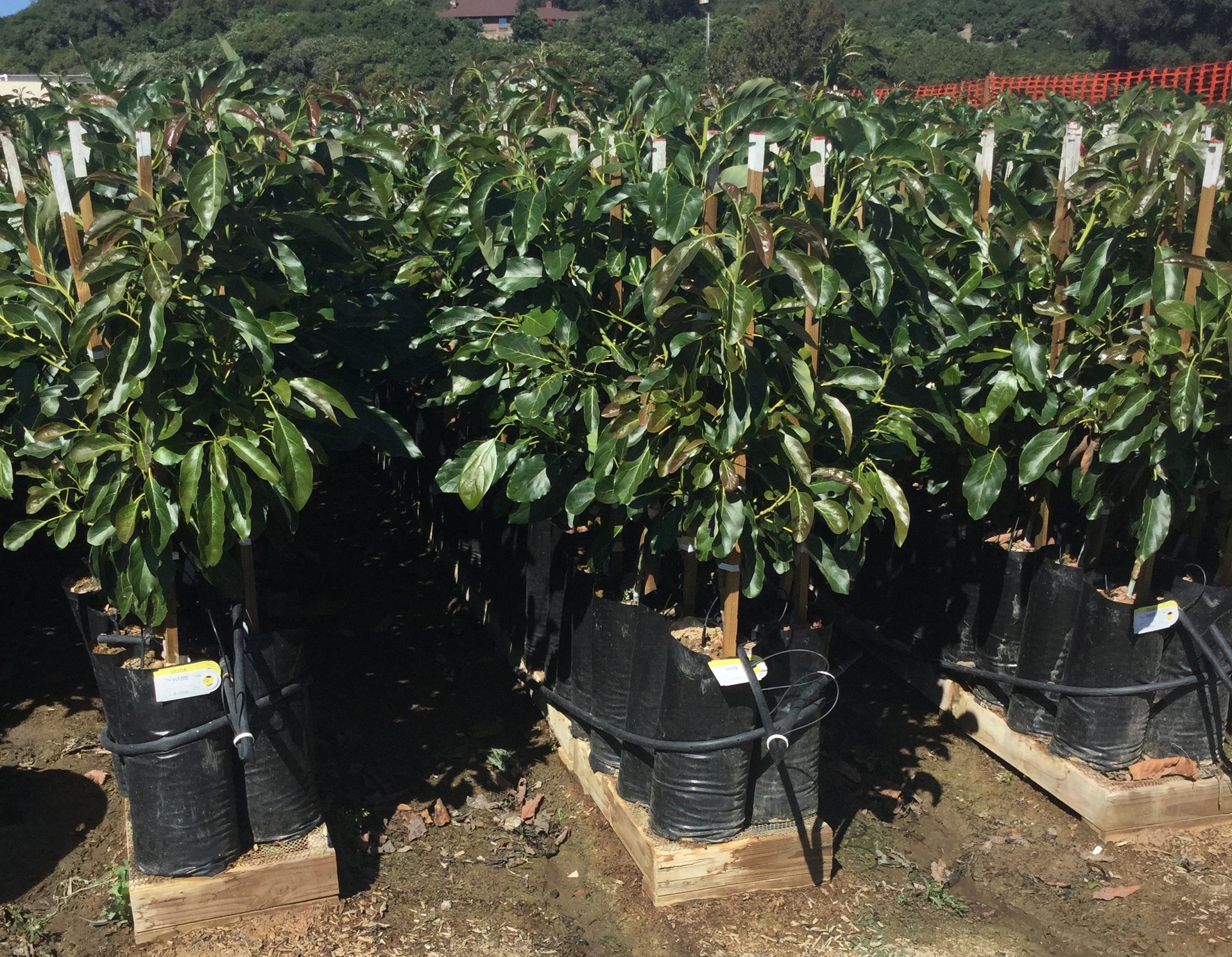June 16, 2025 | 11:06 GMT +7
June 16, 2025 | 11:06 GMT +7
Hotline: 0913.378.918
June 16, 2025 | 11:06 GMT +7
Hotline: 0913.378.918
As of 2022, the total avocado production area worldwide amounts to 491,600 hectares, excluding various smaller regions. Accordingly, the largest avocado-growing region is located in South American countries, which covers 375,400 hectares and constitutes 76% of the world's avocado production area. This region includes Mexico, Peru, Chile, Brazil, and several other countries.
Following closely is the Mediterranean region, encompassing 47,000 hectares, making up 10% of the global total. South Africa contributes 31,000 hectares, representing 6% of the world's avocado production. The United States and Australia each account for only 4% of the total area, which translates to approximately 19,500 hectares. The two main avocado varieties predominantly exported worldwide are Lamb Hass and Hass avocados.

Avocado export area and distribution (based on FRuiTRop, May-June 2023 issue)
In the early 1930s, Rudolph Hass, a postal worker in California, discovered a particularly delicious avocado tree among those he had grown from seeds in his garden. He officially registered the ownership of this tree in 1935, naming it the "Hass" avocado.
However, it was not until the 1970s, following a recommendation by the California Avocado Society, that Hass avocados began to replace the previously prevalent Fuerte variety. The Hass avocado offered a higher fat content, around 20 to 21%, compared to Fuerte's 18%. By the 2005-2006 avocado season, Hass avocados had become the majority crop in California, whereas the Fuerte and Lamb Hass avocado varieties each occupied a small percentage of the total production area.
The Hass avocado, categorized within the A-flower group, exhibits a preference for cooler climates. It is ideally suited for regions characterized by lower temperatures, such as the Central Highlands of Vietnam. Notable preferred locations include Tuy Duc, Di Linh, Da Lat, Mang Den, among others. Namely, the temperature in these areas must reach a minimum of 15 degrees Celsius for twenty consecutive days prior to flowering. Under these specified climatic conditions, Hass avocados can attain the desired size range between 250 and 300 grams.

Failure to meet the aforementioned temperatures will result in the fruits reaching a maximum weight of approximately 200 grams, making it challenging for commercial purposes. Due to misplacement, many farmers in the Buon Ma Thuot and Dak Mil have had to cut down their Hass avocado trees as the small fruits hold little economic value. Vietnamese consumers are accustomed to consuming larger avocados such as the 034 or Tu Quy varieties, often using avocados in milkshakes with milk and sugar.
However, due to its excellent quality, Hass avocados are grown in many countries around the world including the United States, Mexico, Peru, Chile, Australia, New Zealand, Israel, South Africa, etc. It is considered a significant international commodity. In Western countries, the fruit is often consumed as a salad ingredient before the main course or simply sliced, sprinkled with a touch of salt and pepper, and a squeeze of lemon as a breakfast snack. Consequently, the global demand for Hass and Lamb Hass avocados has steadily risen, covering 200,000 hectares over the past seven years.
Hass avocado saplings were still being sold and grafted onto Dusa rootstock at the Brokaw nursery in Southern California by the end of 2015. Many new avocado farms have since been established, with the majority of the crop being Hass avocado.

Hass avocado saplings grafted onto Dusa rootstock at the Brokaw nursery in the United States.
According to Professor Gary Bender, an avocado specialist in Southern California, the development of Lamb Hass avocados first began in the 1980s. Researchers from the University of California planted 1,000 Hass avocado trees in a farm named after Bob Lamb to identify the best-performing Hass varieties. By 1996, they had selected a tree that had similar fruit characteristics to Hass but with distinct advantages:
- Larger fruit size compared to that of the Hass variety.
- Higher fruit yield per tree.
- Later fruit ripening period compared to that of the Hass variety.
- More compact tree growth, allowing for denser planting.
- Less susceptibility to pests and diseases.
This exceptional avocado tree was chosen from among the 1,000 planted Hass trees. Subsequently, the University of California named the tree Lamb Hass in honor of the Lamb family, who were the landowners of the experimental site. In 1996, the University of California patented Lamb Hass.
According to Professor Gary, many Northern Californian farmers have noted that Lamb Hass avocados have higher yields compared to that of the Hass variety, despite having the slightly lower initial selling price of the two. However, the Lamb Hass variety boasts a higher profitability per acre at 8,298 USD compared to Hass's 5,582 USD. Within a few years, the prices of both avocado varieties became more comparable.
Due to the small size of Hass avocados, which typically weigh around 200 to 250 grams, major avocado exporting countries, including Mexico, Chile, and South Africa, have gradually replaced Hass with Lamb Hass avocados. Lamb Hass avocados are favored for their larger fruit size, which averages between 300 and 350 grams. Avocado packaging facilities such as Calavo in Ventura, Southern California, and Westfalia in South Africa predominantly packaged Lamb Hass avocados for export. Both Westfalia and Calavo are prominent global brands in the avocado export industry.

Packaged Lamb Hass avocados at Westfalia in South Africa. Photo: Nguyen Minh Chau.
Many regions in Vietnam are suitable for the production of Lamb Hass or Hass avocados due to their lower temperature requirements. Several regions, where the minimum temperature remains at or below 15 degrees Celsius for at least twenty consecutive days before flowering, are ideal for avocado production. These include highland areas and hilly regions in various provinces in the northern part of Vietnam such as A Luoi in Thua Thien Hue, Moc Chau in Son La, Dien Bien, Lai Chau, and other locations with a cold climate suitable for growing Lamb Hass or Hass avocados.
In addition to temperature requirements, avocados are susceptible to root rot diseases. As a result, it is essential to implement comprehensive and promptly disease prevention measures, with proper soil drainage being the most crucial factor. Utilizing rootstocks with resistance to root rot, such as Duke 7, Dusa from the United States, or Zutano from Australia, is vital for a successful avocado farm.
Access to Dusa rootstock in Vietnam is currently restricted due to ongoing copyright restrictions. However, Duke 7 and Zutano, which offer low levels of resistance to root rot, can be obtained from Brokaw nurseries in California and used as rootstocks to improve disease resistance over using common and unnamed rootstocks in Vietnam.

Carefully packaged avocados in South Africa. Photo: Nguyen Minh Chau.
To produce high-quality avocados, it is essential to apply fertilizer correctly to ensure that the fruits reach their maximum fat content. Additionally, avocados must be harvested at the precise moment when the variety, such as Hass, reaches its peak fat content, which typically falls within the range of 20 to 21%.
Vietnamese soil offers ample potential for producing export-grade Lamb Hass and Hass avocados. Major avocado exporting countries around the world including Mexico (the world's largest exporter), South Africa, and the United States predominantly produce Lamb Hass. These avocados exhibit larger and visually appealing fruits compared to that of the Hass variety, despite both sharing a striking similarity.
On the other hand, smaller avocado exporting countries such as Israel and Australia, as well as a small portion of American consumers, still hold a preference for Hass avocados.
Therefore, the choice between Hass and Lamb Hass depends on the preferences of individual countries and the adaptability of the avocado variety to regional conditions.
With the aim of granting Vietnamese consumers access to delicious Hass and Lamb Hass avocados as well as ensuring that the avocados meet international export standards, the Vietnamese avocado industry must undertake several crucial initiatives, including: Producing disease-free avocado saplings with disease-resistant rootstocks, similar to practices observed in other countries; Implementing meticulous production techniques to mitigate potential outbreak of diseases such as root rot; Applying NPK fertilizers and harvesting avocados at the optimal stage to attain the highest fat content; Enforcing stringent quality control measures in packaging facilities; Establishing packaging centers in key production regions; Developing ripening rooms to ensure avocados reach consumers in perfect condition.
Although the Vietnamese avocado industry faces numerous challenges, including the accessibility of disease-resistant rootstocks such as Dusa, these obstacles can be gradually overcome. Many foreign companies, bolstered by experienced specialists, stand prepared to collaborate with Vietnamese counterparts in exploring and capitalizing on the potential of avocado production for export.
It is likely that Vietnam may emerge as a prominent avocado exporting country in the near future, which shares the international stage with key players such as Mexico, Chile, South Africa, Peru, the United States, and Israel. The country's diverse terrain provides ample suitability for the production of both Lamb Hass and Hass avocados, holding the potential of a mutually beneficial scenario for all stakeholders.
Translated by Nguyen Hai Long
![Turning wind and rain into action: [4] Bringing climate bulletins to remote and isolated areas](https://t.ex-cdn.com/nongnghiepmoitruong.vn/608w/files/linhnhp/2025/06/14/1152-z6704423696987_15fd32ffc26d590d204d520c9dac6786-nongnghiep-151141.jpg)
(VAN) The Vietnam Agriculture and Nature Newspaper interviewed Mr. Vu Thai Truong, Acting Head of Climate Change and Environment at UNDP Vietnam, to gain deeper insight into how climate bulletins are delivered to farmers.

(VAN) In Tien Giang, a high-tech shrimp farm has developed a distinctive energy-saving farming model that has yielded promising results.
![Turning wind and rain into action: [3] 300.000 farmers benefit from agro-climatic bulletins](https://t.ex-cdn.com/nongnghiepmoitruong.vn/608w/files/news/2025/06/12/e5a48259d6a262fc3bb3-nongnghiep-125122.jpg)
(VAN) The agro-climatic bulletin has become a valuable tool for farmers in the Mekong Delta. After more than five years of implementation, the initiative is gradually being expanded nationwide.
![Turning wind and rain into action: [2] Providing forecasts to the people](https://t.ex-cdn.com/nongnghiepmoitruong.vn/608w/files/news/2025/06/12/e5a48259d6a262fc3bb3-nongnghiep-103927.jpg)
(VAN) In addition to improving the quality of hydrometeorological forecasts, putting forecast bulletins into practical use is crucial for production and disaster prevention.

(VAN) Blue carbon is receiving attention for its rapid absorption capacity and vast potential. It represents a promising nature-based solution to respond to climate change.
/2025/06/11/3507-1-161904_583.jpg)
(VAN) Seagrass beds and coral reefs serve as 'cradles' that nurture life in the ocean depths, creating rich aquatic resources in Vietnamese waters.
![Turning wind and rain into action: [1] Forecasting for farmers](https://t.ex-cdn.com/nongnghiepmoitruong.vn/608w/files/news/2025/06/11/e5a48259d6a262fc3bb3-nongnghiep-111919.jpg)
(VAN) Weather is no longer just a matter of fate. Forecasts have now become an essential companion for farmers in every crop season.